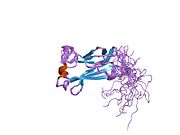
P300/CBP-associated factor (PCAF), also known as K(lysine) acetyltransferase 2B (KAT2B), is a human gene and transcriptional coactivator associated with p53.

5′-3′ exoribonuclease 1 (Xrn1) is a protein that in humans is encoded by the XRN1 gene. Xrn1 hydrolyses RNA in the 5′ to 3′ direction.

Paired amphipathic helix protein Sin3a is a protein that in humans is encoded by the SIN3A gene.

Nuclear transcription factor Y subunit alpha is a protein that in humans is encoded by the NFYA gene.

Nuclear transcription factor Y subunit beta is a protein that in humans is encoded by the NFYB gene.

DNA-binding protein inhibitor ID-1 is a protein that in humans is encoded by the ID1 gene.

Transcriptional regulator ATRX also known as ATP-dependent helicase ATRX, X-linked helicase II, or X-linked nuclear protein (XNP) is a protein that in humans is encoded by the ATRX gene.

Krueppel-like factor 5 is a protein that in humans is encoded by the KLF5 gene.

Core histone macro-H2A.1 is a protein that in humans is encoded by the H2AFY gene.

Euchromatic histone-lysine N-methyltransferase 2 (EHMT2), also known as G9a, is a histone methyltransferase enzyme that in humans is encoded by the EHMT2 gene. G9a catalyzes the mono- and di-methylated states of histone H3 at lysine residue 9 and lysine residue 27.

Transcriptional regulator Kaiso is a protein that in humans is encoded by the ZBTB33 gene. This gene encodes a transcriptional regulator with bimodal DNA-binding specificity, which binds to methylated CGCG and also to the non-methylated consensus KAISO-binding site TCCTGCNA. The protein contains an N-terminal POZ/BTB domain and 3 C-terminal zinc finger motifs. It recruits the N-CoR repressor complex to promote histone deacetylation and the formation of repressive chromatin structures in target gene promoters. It may contribute to the repression of target genes of the Wnt signaling pathway, and may also activate transcription of a subset of target genes by the recruitment of catenin delta-2 (CTNND2). Its interaction with catenin delta-1 (CTNND1) inhibits binding to both methylated and non-methylated DNA. It also interacts directly with the nuclear import receptor Importin-α2, which may mediate nuclear import of this protein. Alternatively spliced transcript variants encoding the same protein have been identified.

Homeobox protein Hox-B9 is a protein that in humans is encoded by the HOXB9 gene.

Tripartite motif-containing protein 37 is an E3 ubiquitin ligase in humans that is encoded by the TRIM37 gene.

NKG2-C type II integral membrane protein or NKG2C is a protein that in humans is encoded by the KLRC2 gene. It is also known as or cluster of differentiation 159c (CD159c).

Zinc finger and BTB domain-containing protein 7A is a protein that in humans is encoded by the ZBTB7A gene.

Histone H2A type 3 is a protein that in humans is encoded by the HIST3H2A gene.

The Chromodomain-Helicase DNA-binding 1 is a protein that, in humans, is encoded by the CHD1 gene. CHD1 is a chromatin remodeling protein that is widely conserved across many eukaryotic organisms, from yeast to humans. CHD1 is named for three of its protein domains: two tandem chromodomains, its ATPase catalytic domain, and its DNA-binding domain.

Histone H4 transcription factor is a protein that in humans is encoded by the HINFP gene.

SET and MYND (myeloid-Nervy-DEAF-1) domain-containing protein 3 is a protein that in humans is encoded by the SMYD3 gene.

Forkhead box protein A1 (FOXA1), also known as hepatocyte nuclear factor 3-alpha (HNF-3A), is a protein that in humans is encoded by the FOXA1 gene.

























